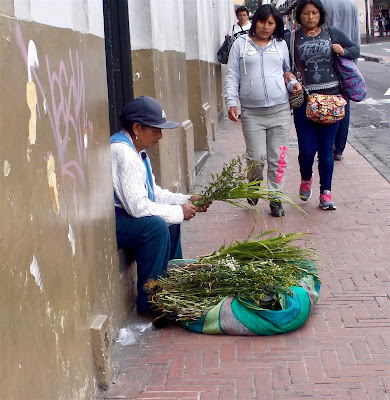We arrived at Quito's new airport in the late morning. The airport is a long drive - 18km - from the centre of the city and the services connecting the two are not yet straightforward. The airport shuttle we took dropped us at a bus terminal where we had to get a taxi for the remainder of the journey. A taxi directly from the airport to the city centre would have been cheaper and more convenient.
Although Quito is very close to the equator, its location 2,850 metres above sea level means that the air is cool. During our stay the weather was quite changeable: sometimes dark and cloudy with an occasional rain shower, sometimes bright and sunny.
Our hotel, in a historic building adjoining a pedestrian street, had a lovely central courtyard festooned with greenery.
However, only a few of the rooms opened onto this space. Ours opened off a corridor that ran around the outside wall of the building. This corridor had lovely casement windows overlooking the street, but the room only had a skylight and high transom windows opening onto the corridor. The room itself had a high ceiling and was spacious and comfortable, but the lack of a view out, even if only into a light well, was a drawback.
The location was excellent for walking around the inner city and we were impressed by the number of streets in this area that have been turned into pedestrian thoroughfares.
The wide avenues provided lots of space for vendors of various goods - like flowers,
... fruit,
... grilled plantains
...and particularly soft icecream, which seemed to be a local favourite.

A one-man band attracted much less attention.
The old centre of the city has its share of beautiful colonial buildings.



This last one faced a square full of pigeons, which also made it a popular place for young children.
We visited the museum, housed in a lovely old mansion with a tranquil courtyard.
From the terrace of its very modern addition, we had good views of the densely-populated hillsides.
Among the most impressive exhibits inside were a couple of unusual parquet floors (hard to photograph because of the slanting light.)
Not all the interesting art was in the museum. This mosaic, high on a wall above a bus stop was easy to miss, but it caught my eye.
So did this giant monkey-puzzle tree (Araucaria verticillata) in one of the many plazas.
In many modern cities in North America the art of window-dressing seems to have died out. Not so in Quito where colourful fabrics in particular were artistically displayed.
On one of the warmest days we visited the botanic garden, where one of the first things we saw was a young man teaching his little son how to water the plants.
There was lots of lush foliage to admire,
... and some fascinating flowers.
An interesting detail was the use of decaying water hyacinths as a mulch around a bed of roses.
But the highlight was their orchid collection. I took a lot of photos but restricted myself to just a few for this blog.



















































